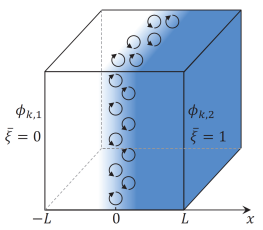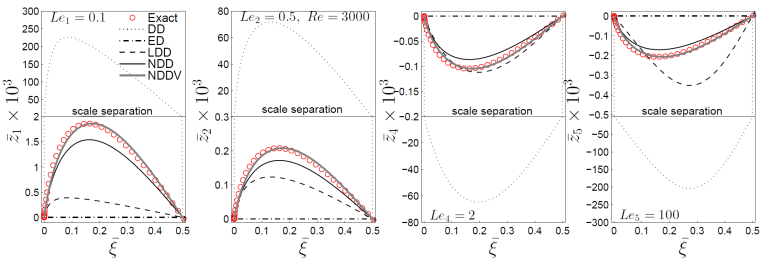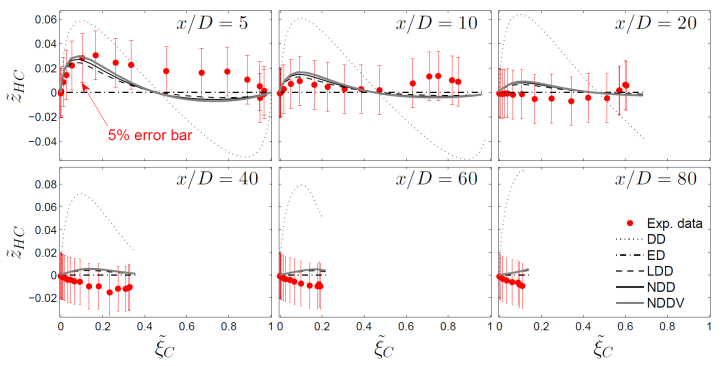Reports: DNI953781-DNI9: Study of Detailed Molecular Transport in Laminar Flamelet and Turbulent Non-Premixed Combustion
Haifeng Wang, PhD, Purdue University
1. Overview
Treating differential molecular diffusion correctly and accurately remains as a great challenge to the modeling of turbulent non-premixed combustion. The aim of this project is to develop consistent modeling strategies for differential molecular diffusion in the flamelet modeling framework. Two types of differential molecular diffusion models are developed, linear differential diffusion models (LDD) and nonlinear differential diffusion models (NDD). A multi-component turbulent mixing layer problem is analyzed in detail to gain insights into differential molecular diffusion and its characteristics, particularly the dependence of differential molecular diffusion on the Reynolds number and the Lewis number. These characteristics are then used to validate the differential molecular diffusion models. Finally, the new models are applied to the modeling of a laboratory-scale turbulent jet flame to further assess the models' performance.
2. Differential Molecular Diffusion Models
The two types of differential molecular diffusion models have been successfully developed during the first year of the project: LDD and NDD. The models are constructed based on a limiting analysis of differential molecular diffusion in the limits of small and infinite large Reynolds number Re. As shown in Figure 1, in the limit of low Re, full differential molecular diffusion is expected since there is no turbulence effect, while in the other limit of infinitely large Re, simple equal diffusion is anticipated since turbulent diffusion dominates molecular diffusion and there is typically no differential diffusion effect in turbulent transport.
Based on this limiting analysis, the LDD model linearly blends the two limits at small and large Re, by using the degree of differential molecular diffusion θ which is defined as θ=r/(1+r) and r is the ratio of a representative molecular diffusivity DM and the turbulent diffusivity DT, r= DM/DT. The NDD model is constructed by attenuating the molecular Lewis number using θ such that it is consistent with the above limiting behaviors. A further correction is added to the NDD model, called NDDV model, to account for the effect of non-zero variance on differential molecular diffusion. All the three new models, LDD, NDD, and NDDV, together with previous models ED (equal diffusion) and DD (a previous differential diffusion model that is inconsistent with the limiting behavior of differential molecular diffusion) are thoroughly validated in a turbulent mixing layer and in a laboratory scale turbulent CH4/H2/N2 jet flames.
Figure 1. Analysis of the limiting behaviors of differential molecular diffusion when Re→0 and Re→∞.
3. Validation of Models in Turbulent Mixing Layer
Figure 2. Mixing layer in homogeneous isotropic turbulence
The differential molecular diffusion models are firstly validated in an idealized mixing layer in homogeneous isotropic turbulence as shown in Figure 2. The analytical solution for the mixing layer exists and can be used to validate the models. The model predictions and their comparison with the analytical solutions of the turbulent mixing layer with Re=3000 are shown in Figure 3. We can see that the old models (ED and DD) cannot predict the level of differential molecular diffusion correctly in the mixing layer, while the new models (LDD, NDD, NDDV) can capture it reasonably well. Comparing the three new models, we can see that the NDDV model performs the best, the LDD model the least, and the NDD model in between. Detailed characteristics of the models are also examined during the project year, including the effect of Reynolds number and Lewis number on differential molecular diffusion.
Figure
3. Level of differential molecular diffusion z against mixture fraction
in the turbulent mixing layer with Re = 3000.
The performance of the new differential molecular diffusion models is then examined in a laboratory scale turbulent jet flame. The flame consists of a central jet of fuel CH4/H2/N2 and a coflow of air, with a Reynolds number of Re=15,200. In Figure 4, the centerline profiles in the turbulent jet flame are shown of the mean axial velocity, mean and rms mixture fraction, and mean temperature. Except the DD model, all models yield very similar profiles, and all model results agree with the experimental data (circles) well, indicating that the mean fields are insensitive to differential diffusion. The effect of differential diffusion is better revealed by examining the parameter zHC, which is defined as the difference of the mean mixture fractions defined based on the mean mass fractions of element H and C, zHC= ξH-ξC. The variations of zHC against ξC are shown in Figure 5 at the different axial locations x/D in the flame. The DD model (dotted lines) significantly overpredicts differential diffusion in this flame. The ED model (dash-dotted lines) yields zero zHC throughout the flame as expected. The new models (LDD, NDD, and NDDV) yield similar results which are in reasonably good agreement with the experimental data within the estimated range of measurement uncertainty. The new models developed in this work successfully capture the measured differential diffusion in this flame.
Figure 4. The centerline profiles of the mean axial velocity, mean and rms mixture fraction, and mean temperature in a turbulent CH4/H2/N2 nonpremixed jet flame.
Figure
5. The variation of zHC against mixture fraction ξC
in the turbulent CH4/H2/N2 nonpremixed jet
flame at the different axial locations x/D.
Consistent differential molecular diffusion models are introduced to the combustion community to help develop rigorous modeling methods to account for detailed molecular transport in turbulent flames. The grant assists the career development of the PI towards his goal of developing predictive models for turbulent reacting flows. The grant also supports a graduate student, Mr. Tianfang Xie, for his PhD study, under the PI’s supervision.
6. Future Work
During next project year, the following work is planned:
1. DNS test cases from Sandia National Laboratories will be used to assess the models more thoroughly;
2. Further examination of the differential molecular diffusion models in Sandia piloted jet flames series will be performed to gain deep insights into the effect of Re on differential molecular diffusion.
















